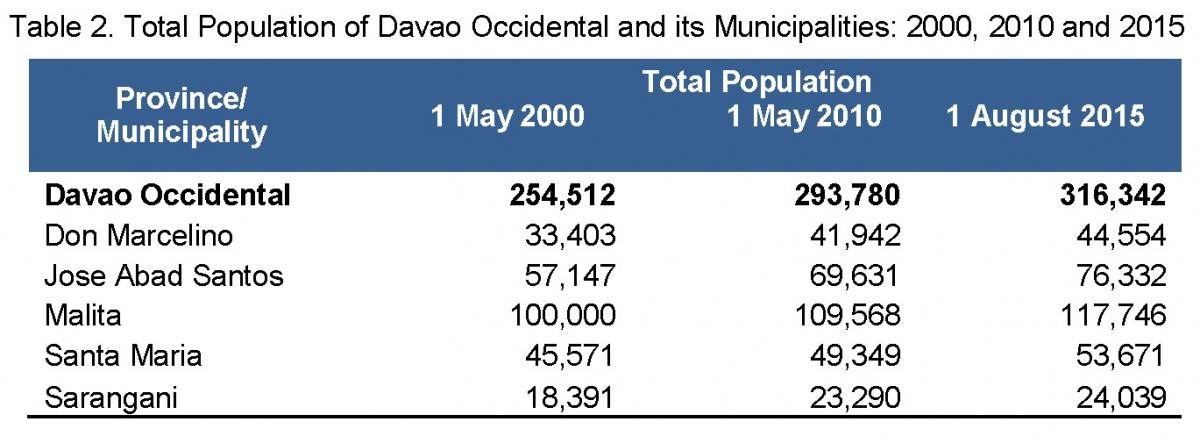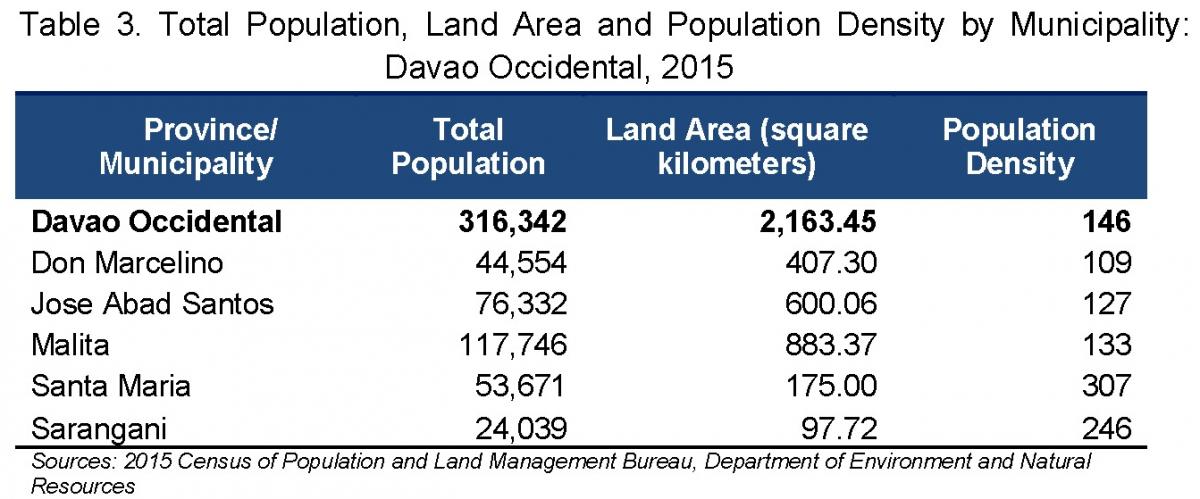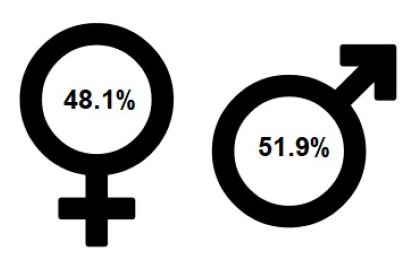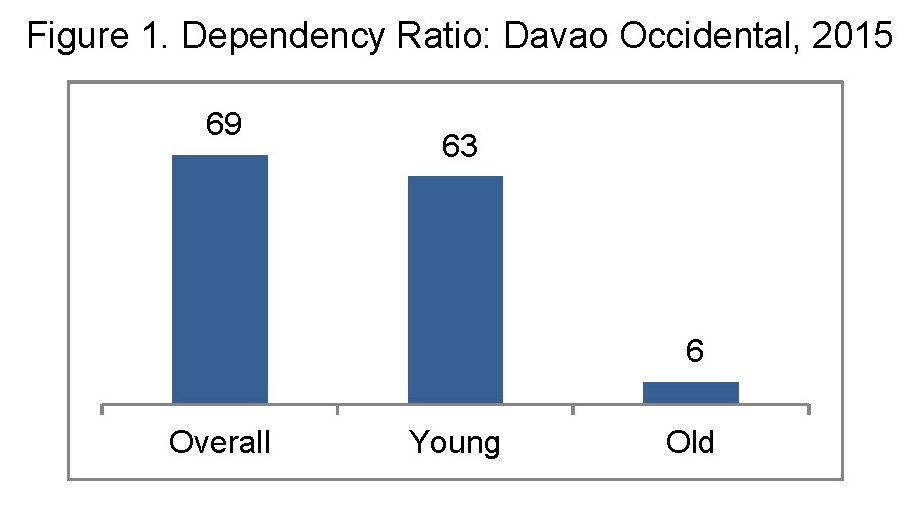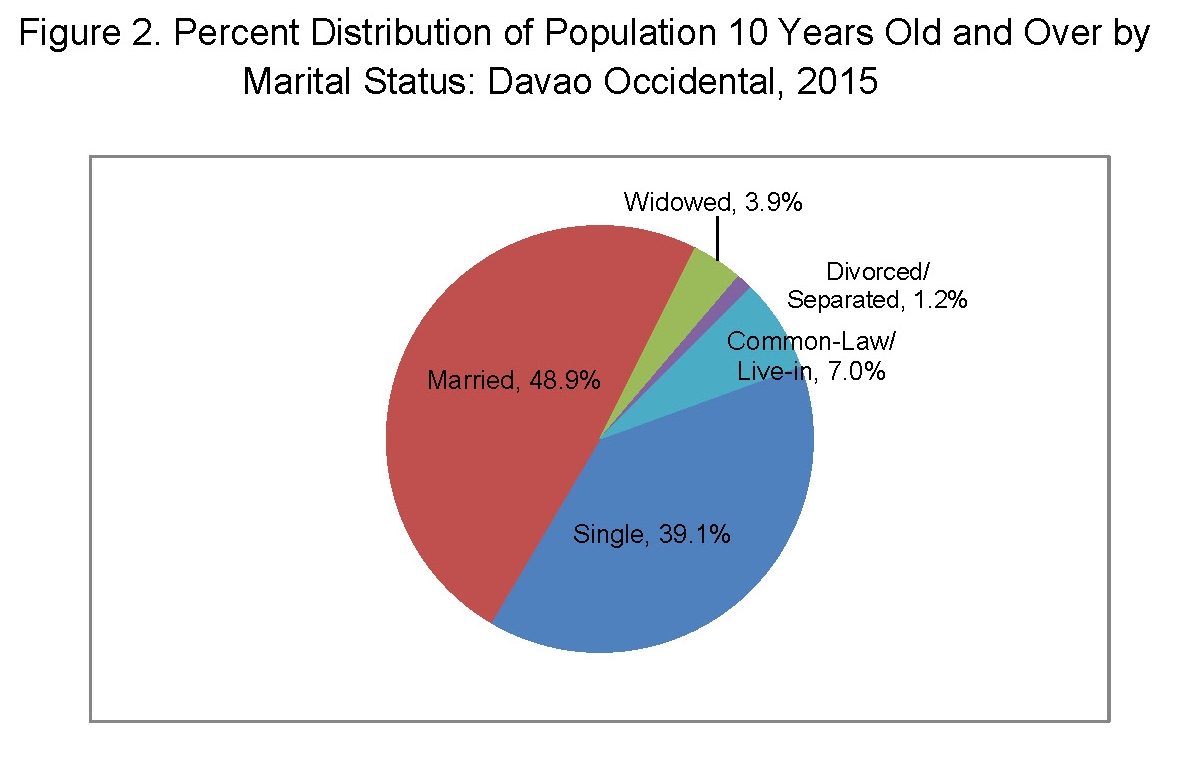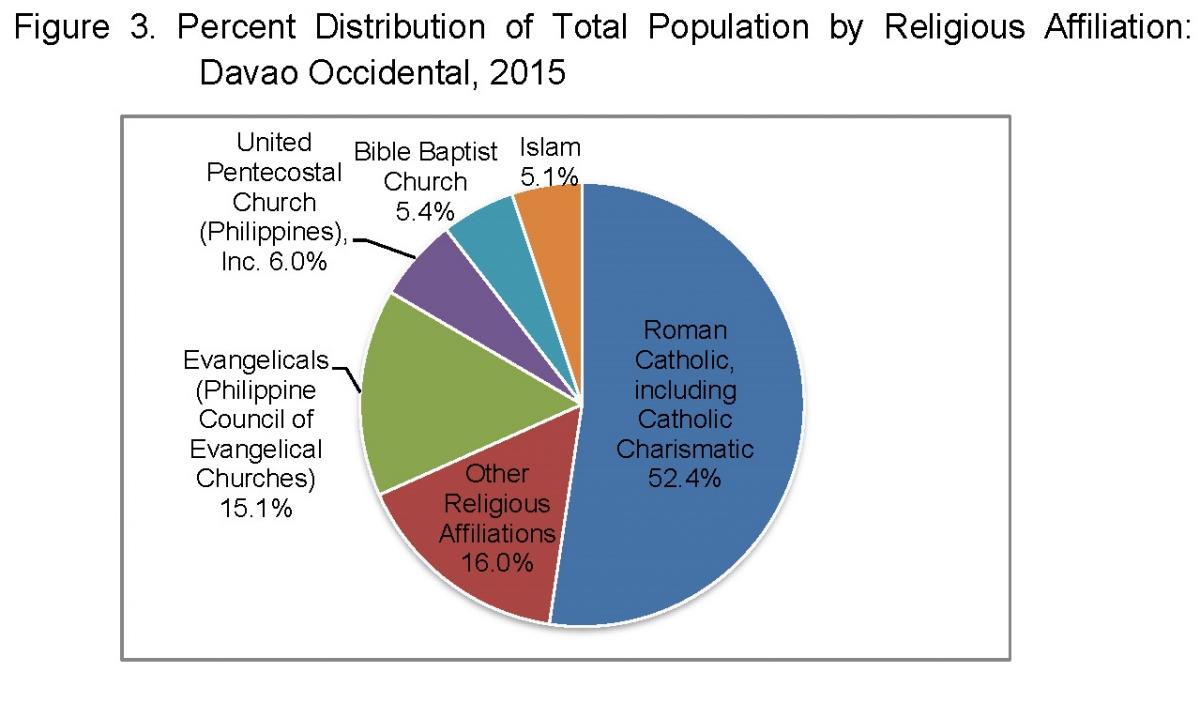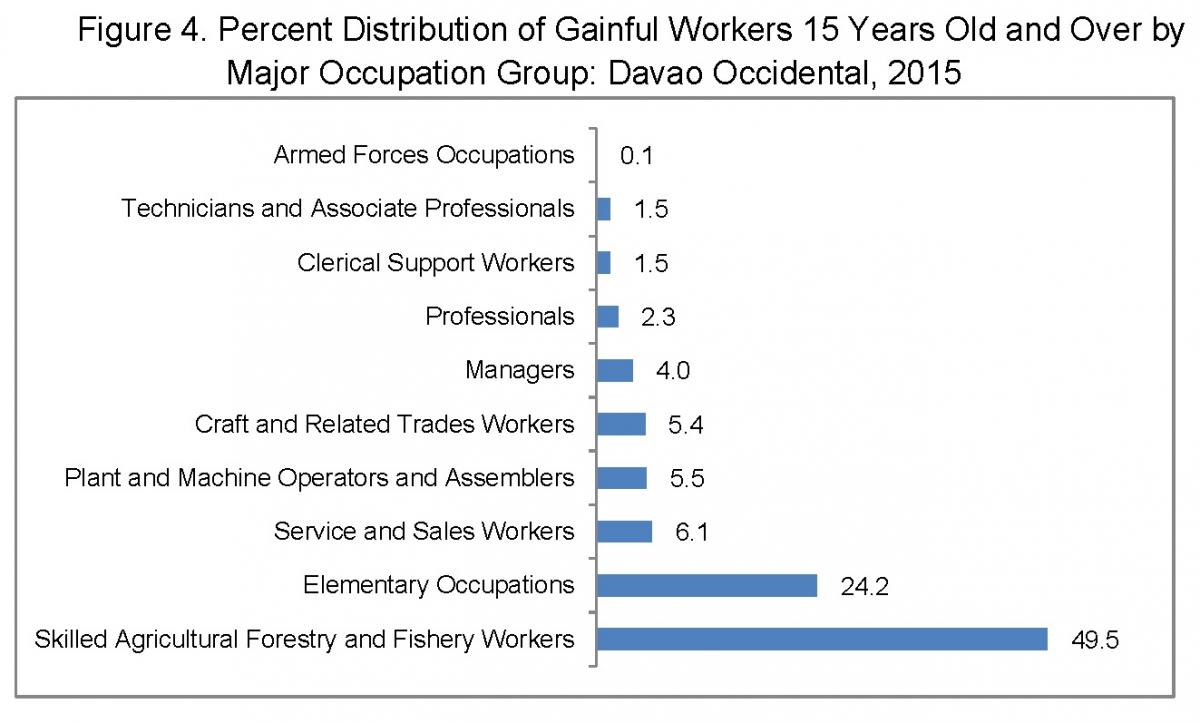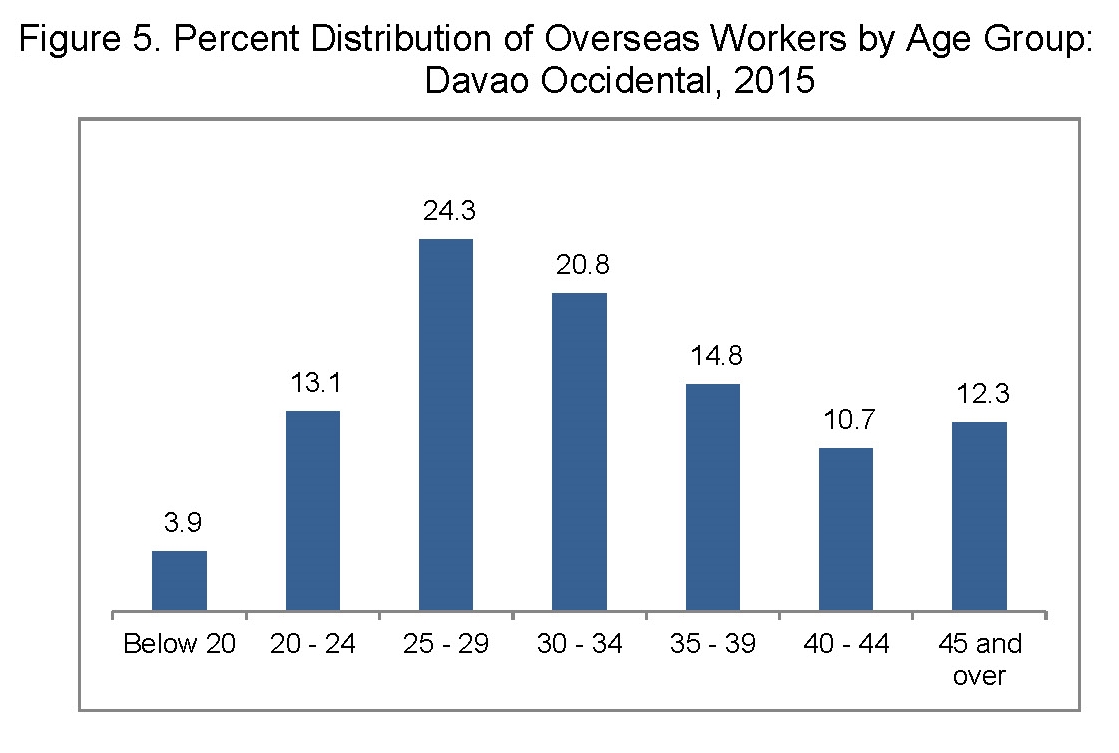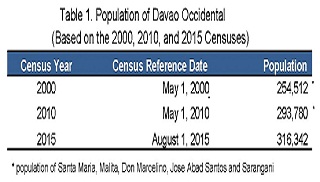 Davao Occidental is the 81st province by virtue of RA 10360
Davao Occidental is the 81st province by virtue of RA 10360
Davao Occidental is the 81st and newest province by virtue of Republic Act No. 10360 known as “Charter of the Province of Davao Occidental” enacted on July 23, 2013. The new province was carved out from the southern part of Davao del Sur, consisting of the municipalities of Santa Maria, Malita, Don Marcelino, Jose Abad Santos and Sarangani.
Total population went up by 22 thousand persons
As of 1 August 2015, Davao Occidental had a total population of 316,342 based on the results of the 2015 Census of Population. The province comprised of 6.46 percent of Davao Region’s total population.
The 2015 population of Davao Occidental is higher by 22,562 compared with the population of 293,780 in 2010. Based on the results of the 2000 Census of Population and Housing, the total population of the province was 254,512.
Population increased by 14 persons per year for every 1,000 persons
Davao Occidental is growing at an average population growth rate of 1.42 percent annually during the period 2010 to 2015. This means that there were about 14 persons added per year for every 1,000 persons in the population.
By comparison, the annual PGR was slightly higher during the period 2000 to 2010 at 1.44 percent.
If the current annual growth rate continues, the population in the province is expected to double in 49 years (2064).
One in every three persons in the province resided in Malita
One in every three persons in the province was residing in Malita. It had the biggest population among the municipalities in 2015 with 117,746, followed by Jose Abad Santos with 76,332. Santa Maria had a population of 53,671, Don Marcelino with 44,554 and Sarangani with 24,039.
Population density of Davao Occidental increased from 136 to 146 persons per square kilometer
With a total land area of approximately 2,163 square kilometers, the population density of Davao Occidental posted at 146 persons per square kilometer. There was an increase of 10 persons per square kilometer, from the population density in 2010 at 136 persons per square kilometer.
Among the municipalities, Santa Maria was most densely populated with 307 persons per square kilometer, followed by Sarangani with 246 persons per square kilometer.
Males outnumber females
Of the total population, 51.9 percent were males while 48.1 percent were females. This translated to a sex ratio of 108 males for every 100 females.
Don Marcelino posted the highest sex ratio of 109 males for every 100 females. Malita and Sarangani had the lowest sex ratio with 107.
Median age was 20.9 years
In 2015, the median age of the province’s total population was 20.9 years, which means that half of the total population was below 20.9 years.
Children aged 0 to 4 years and 5 to 9 years comprised the largest groups
The age-sex distribution of the population showed that children aged 5 to 9 years and 0 to 4 years comprised the largest age groups with corresponding percentages of 12.4 and 13.1. This was followed by those in the age groups 10 to 14 years (11.7 percent) and 15 to 19 years (10.3 percent).
Males outnumbered females in the age group 0 to 69 years old. Females, on the other hand, outnumbered their male counterparts in the older age groups (70 years old and over).
Dependency ratio was 69 dependents per 100 persons in the working-age group
Of the total household population, 59.2 percent belonged to the working-age population (15 to 64 years old). Children below 15 years of age comprised of 37.3 percent while older persons (65 years and over) accounted for 3.6 percent.
The overall dependency ratio of the province in 2015 was 69 dependents for every 100 persons in the working age group. Of the 69 dependents, 63 were young dependents while six were old dependents.
More than half of the population is of voting-age
The voting-age population (18 years old and over) in Davao Occidental accounted for 56.4 percent of the total population in 2015.
Among the voting-age population, 52.4 percent were males and 47.6 percent were females.
Average household size in 2015 was 4.1 persons
The household population of the province in 2015 was 315,754, higher by 21,993 persons from the household population of 293,761 persons in 2010.
The number of households, meanwhile, increased by 19.6 percent from 64,741 in 2010 to 77,431 in 2015.
The average household size in 2015 was 4.1, lower than the average household size of 4.5 persons in 2010.
More males than females among never-married persons
Of the total population 10 years old and over, 39.1 percent were never married while 48.9 percent were married. The rest of the population was categorized as follows: in common law/live-in arrangement (7.0 percent), widowed (3.9 percent), divorced/separated (1.2 percent), and had unknown marital status (less than 0.1 percent).
Among the never-married persons, a higher proportion of males (57.5 percent) than females (42.5 percent) was reported in 2015. Meanwhile, the proportion of females was higher than males among those who were widowed (71.0 percent) and divorced/separated (52.3 percent).
Females outnumbered males among baccalaureate degree holders
Of the total population 5 years old and over, 57.4 percent had attended or completed elementary education, 22.6 percent had reached or finished high school, 3.9 percent were college undergraduate, and 2.1 percent were baccalaureate/college graduate.
Among those with bacallaureate degree, there were more females (61.1 percent) than males (38.9 percent). Similarly, among those with post-bacallaureate courses, females (60.8 percent) outnumber males (39.2 percent).
School attendance rate was higher among females than among males
Of the 138,903 household population aged 5 to 24 years old, 64.9 percent were attending school for School Year 2015-2016.
By sex, the school attendance rate in 2015 was higher among females (65.9 percent) than among males (63.8 percent).
Literacy rate was slightly higher among females than among males
Davao Occidental posted a literacy rate of 90.3 percent among the household population aged 10 years old and over. A person is considered literate if he/she is able to read and write a simple message in any language or dialect.
Literacy rate was slightly higher among females (90.8 percent) than among males (89.9 percent).
More than half of the population were Roman Catholics
More than half (52.4 percent) of the total population in Davao Occidental reported Roman Catholic as their religious affiliation.
The next religious affiliation in the province was Evangelicals (Philippine Council of Evangelical Churches), comprising 15.1 percent. It was followed by those affiliated with United Pentecostal Church (6.0 percent), Bible Baptist Church (5.4 percent) and Islam (5.1 percent).
Almost three in every five persons were engaged in a gainful activity
In 2015, the province had 198,066 household population aged 15 years and over. Of this total, 56.5 percent were engaged in a gainful activity during the 12 months preceding the survey.
By major occupation group, skilled agricultural forestry and fishery workers comprised the largest group (49.5 percent), followed by workers engaged in elementary occupations (24.2 percent).
There were more females than their male counterparts for these major occupation groups: managers (58.7 percent), professionals (70.8 percent), technicians and associate professionals (53.6 percent), clerical support workers (51.3 percent) and service and sales workers (55.4 percent).
However, there were more males than females for these occupation groups: skilled agricultural forestry and fishery workers (90.7 percent), craft and related trades workers (68.2 percent), plant and machine operators and assemblers (98.3 percent), elementary occupations (75.9 percent) and armed forces occupations (95.9 percent).
About 0.7 percent of the household population were overseas workers
Of the household population 15 years old and over, 1,321 persons or 0.7 percent were overseas workers.
Two in every three (66.2 percent) overseas workers were females.
Overseas workers aged 25 to 29 made up the largest age group, comprising 24.3 percent of the total overseas workers. This was followed by age group 30 to 34 (20.8 percent) and age group 35 to 39 (14.8 percent).
TECHNICAL NOTES
| Population growth rate | the rate at which the population is increasing (or decreasing) in a given period due to natural increase and net migration, expressed as a percentage of the base population |
| Total population | the sum of the household population and institutional population. It also includes Filipinos in Philippine embassies, consulates, and missions abroad |
| Household population | comprises of persons who belong to a household, the basic criterion of which is the usual place of residence or the place where the person usually resides |
| Institutional population | the population enumerated in collective or institutional living quarters such as: dormitories/lodging houses, jails/prisons, military camps, convents/seminaries, and mental hospitals |
| Household | a social unit consisting of a person living alone or a group of persons who sleep in the same housing unit and have a common arrangement in the preparation and consumption of food |
| Average household size | the average number of persons who live in the household, computed as the household population in a given area divided by the corresponding total number of households in that area |
| Sex ratio | the ratio of males to females in a given population, expressed as the number of males per 100 females |
| Age | the interval of time between a person’s date of birth and the census reference date (1 August 2015). Expressed in completed years (as of last birthday), it is recorded in whole number |
| Median age | the age at which exactly half of the population is younger than this age and the other half is older than it |
| Overall dependency ratio | the ratio of persons in the dependent ages (under 15 years old and over 64 years old) to persons in the economically active or working ages (15 to 64 years old) in the population |
| Marital status | the personal status of each individual with reference to the marriage laws or customs of the country |
| Religious affiliation | a particular system of beliefs, attitudes, emotions, and behaviors constituting man’s relationship with the powers and principalities of the universe |
| School attendance rate | the proportion of persons 5 to 24 years old who were attending school during the School Year June 2015 to March 2016 to school-age population (5 to 24 years old) |
| Simple literacy rate | the proportion of persons aged 10 years and over who are able to read and write a simple message in any language or dialect |
| Highest grade / year completed | the highest grade or year completed in school, college or university |
| Usual activity / occupation | the kind of job or business, which a person aged 15 years and over was engaged in most of the time during the 12 months preceding the census |
| Overseas worker | a household member (15 years old and over) who is out of the country due to an overseas employment |
The 2015 Census of Population (POPCEN 2015) was undertaken by the Philippine Statistics Authority in August 2015 as mandated by Republic Act No. 10625, otherwise known as the Philippine Statistical Act of 2013. It was the 14th census of population that was undertaken since the first census in 1903. POPCEN 2015 was designed to take an inventory of the total population all over the Philippines and collect information about their characteristics. Census day for the POPCEN 2015 was August 1, 2015 (12:01 a.m.). POPCEN 2015 made use of the de jure concept of enumeration wherein households and persons are enumerated in the area where they usually reside as of the census reference date.
IMELDA A. AGUSTIN
Chief Statistical Specialist
PSA-Davao Occidental
 Davao Occidental is the 81st province by virtue of RA 10360
Davao Occidental is the 81st province by virtue of RA 10360